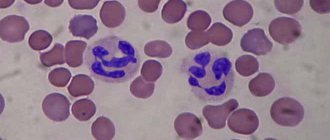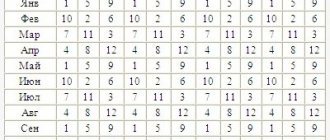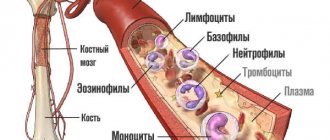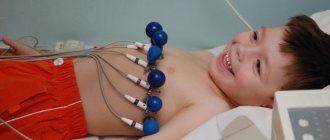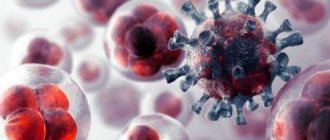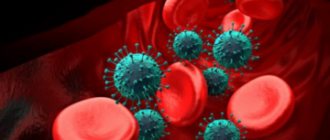The norm of band and segmented neutrophils in a blood test
Neutrophils are the most numerous type of leukocytes, which belong to the subgroup of granulocytes and are responsible for the primary protective functions of the immune system.
Their determination is included in a detailed general blood test with leukemia calculation. In the CBC printout, neutrophils are abbreviated in English as NEUT (NEU). In the diagnosis of many diseases and monitoring the dynamics of the pathological process during treatment, the qualitative and quantitative determination of neutrophils plays an important role.
An increase and decrease in their number helps determine the type of pathogenic microorganisms, the severity and duration of the pathological process, as well as the state of nonspecific immunity.
But before we analyze the causes of neutrophilia and neutropenia, as well as a shift in the leukocyte formula, we will consider the types of neutrophils, the norm of their content in the blood of children and adults, as well as the functions they perform.
Development, varieties and structure
During hematopoiesis, the bone marrow stem cell is the precursor for a number of blast cells, one of which is the myeloblast. It is from this that all granulocytes begin their development. The differentiation and development of neutrophils can be expressed in the following scheme: myeloblast ⇒ promyelocyte ⇒ myelocyte ⇒ metamyelocyte ⇒ band neutrophil ⇒ segmented neutrophil.
Neutrophils, as well as eosinophils and basophils, belong to granulocytic blood cells, since a characteristic feature of these blood cells is the presence of grains (granules) in the cytoplasm.
Neutrophil granules contain lysozyme, myeloperoxidase, neutral and acid hydrolases, cationic proteins, lactoferrin, collagenase, aminopeptidase. It is thanks to the contents of the granules that neutrophils perform their functions.
Peripheral blood contains only 1% of neutrophils of the total number in the body, 60% of neutrophils are found in the bone marrow and about 40% of neutrophils are dispersed throughout other organs of the body.
Normally, there are 2 types of neutrophils in the blood of a healthy person:
- Rod
- Segmented
Band neutrophil
Not all neutrophil leukocytes undergo the full stage of maturation in the bone marrow - some cells enter the bloodstream at the stage of the band neutrophil and mature directly in the blood.
After entering the bloodstream, the “band” can already participate in the immune response, but in comparison with its segmented “brother” it is not yet effective enough against foreign microorganisms, because
the process of its maturation is not yet completed.
The norm of band neutrophils in children and adults is 1-5% of the total number of leukocytes.
The percentage increase in band neutrophils in the blood is called a “leukocyte shift to the left,” which means a rejuvenation of the circulating pool of cells.
The reason for this change is a large loss of segmented neutrophils due to bacterial infection or damage to body tissue.
Segmented neutrophil
This is a fully matured neutrophilic leukocyte, ready for full immune defense of the body. Normally, it is the segmented neutrophil that is the main active force among all neutrophilic leukocytes.
In the bloodstream it is in 2 states: parietal and freely circulating. Their ratio is approximately the same - 1:1. The parietal (marginal) pool of neutrophils is a rapidly mobilized reserve that returns to free circulation if necessary.
Microscopic features:
- 2-3 times more than a mature red blood cell
- Low nucleus to cytoplasm (N/C) ratio (more cytoplasm than nucleus)
- The nucleus is mature and divided into 3-5 lobes connected by thin threads of chromatin
- Nucleols are absent
- More cytoplasm only with secondary granules
- Secondary (specific) neutrophil granules (lilac)
Segmented (mature) neutrophil is normal
The total residence time of a neutrophil in the bloodstream is 6-20 hours, after which it migrates through the capillary wall into the tissue. Moving from the vascular bed to the tissue is a “one way ticket”, because The neutrophil does not come back - it either quickly dies in the presence of an inflammatory process or after 3-4 days it is destroyed by apoptosis.
The norm of segmented neutrophils in the blood in adults is 47-72%, in children 18-72% (depending on age, see below).
Normal blood test
The normal levels of neutrophil leukocytes differ for children and adults, this difference is especially strong in young children.
Normal in children
Table No. 1 - the norm of neutrophils in the blood of children
| Child's age | Neutrophil norm, % | |
| Rod | Segmented | |
| 1 day | 5-12 | 50-70 |
| 5 days | 1-5 | 30-50 |
| 1 month | 1-5 | 20-35 |
| 2 months | 1-5 | 18-33 |
| 3 months | 1-5 | 17-32 |
| 6 months | 1-5 | 15-30 |
| 1 year | 1-5 | 20-35 |
| 2 years | 1-5 | 25-40 |
| 3 years | 1-5 | 30-45 |
| 4 years | 1-5 | 32-50 |
| 5 years | 1-5 | 35-55 |
| 10-12 years | 1-5 | 40-60 |
| 15-18 years old | 1-5 | 45-65 |
As can be seen from the table, the normal percentage of neutrophils in children in the first years of life varies greatly:
- The total percentage of neutrophilic leukocytes at birth is maximum - 65-75%: the norm of segmented neutrophils in the blood is 50-70%, band neutrophils - 5-12%
- In the first 2 weeks, the newborn experiences a sharp decrease in neutrophils.
- At the age of 1-12 months, the number of neutrophils in children is minimal - 20-35%: the percentage of segmented neutrophils decreases to 20-35%, the relative rate of band neutrophils in the child’s blood remains stable - 1-5%.
- By the age of 7, their number increases to 50% and continues to gradually increase until the age of 18.
The relationship between neutrophils and lymphocytes
Change in the % ratio of neutrophils and lymphocytes in children
The illustration clearly shows that in childhood there is an inverse relationship between the percentage of neutrophils and lymphocytes:
- At birth, neutrophils are increased, lymphocytes are decreased, but this ratio is short-term.
- Already on the 5th day, normally their number becomes equal - approximately 40-45%. This is the first crossover of neutrophils and lymphocytes in the child’s leukocyte formula.
- By the end of the second week, the picture of the leukocyte formula in children changes dramatically: lymphocytes are increased, and neutrophils are decreased. And this is no longer a short-term phenomenon - for 8-9 months the percentage of neutrophils will be the lowest for the entire period of the child’s development.
- From 9 months of age, gradual growth begins and by 4-5 years the number of lymphocytes and neutrophils again levels out equally (40-45%). This is the second crossover in the leukoformula.
- From age 5 until adolescence, the percentage of neutrophils will increase until it reaches the adult norm.
Normal for women
Table No. 2 - the norm of neutrophils in women (for all ages)
| Index | Neutrophil norm | ||
| Stick eater. | Segmentivore. | Total | |
| Relative content | 1-5% | 45-70% | 47-72% |
| Absolute content | 0.04-0.45*109/l | 1.8-6.3*109/l | 1.88-6.5*109/l |
Normal for men
Table No. 3 - Norm of neutrophils in men (all ages)
| Index | Neutrophil norm | ||
| Stick eater. | Segmentivore. | Total | |
| Relative content | 1-5% | 45-70% | 47-72% |
| Absolute content | 0.04-0.45*109/l | 1.8-6.3*109/l | 1.88-6.5*109/l |
As can be seen from tables No. 2 and No. 3, the norm of neutrophils in the blood for adult women and men is the same and changes slightly throughout life: band neutrophils - 1-5%, segmented - 45-70%.
Normal during pregnancy
In women during pregnancy, the number of neutrophils increases slightly - on average by 3-5% compared to the norm for adults. The longer the pregnancy, the greater the percentage of neutrophils - approximately 1.0-1.5% for each trimester of pregnancy.
Reasons for the increase
Reasons for the decline
Functions of neutrophils
Neutrophils in the human body are responsible for primary nonspecific immunity. They are the first to encounter the infection and, if possible, digest it or present it to lymphocytes to trigger specific immunity.
The main functions of neutrophils are:
- Phagocytosis of foreign particles
- Phagocytosis of destroyed body tissues
- Phagocytosis of bacteria and fungi
- Informing other cells of the immune system about the presence of infection
- Presentation of foreign particles on its surface for the production of antibodies by lymphocytes
Neutrophils are the main “fighters” against microbial cells. This ability is achieved thanks to a number of its qualities:
- Recognition of a foreign cell
- Chemotaxis is the movement of neutrophils towards bacteria
- Absorption of a foreign cell
- Attraction - the adhesion of bacteria to the surface of a neutrophil
- Absorption of a microbe to form a phagolysosome
- Digestion of a foreign particle or microorganism due to lysosome enzymes
A segmented neutrophil is capable of phagocytosing up to 20-30 microbes. The phagocytic activity of rod cells is less pronounced - they are able to absorb only 10-15 pathogenic microorganisms. Any inflammatory process with the formation of pus is the work of neutrophils. Pus is a mass of dead neutrophils and digested microorganisms.
Structural changes in neutrophils
In the diagnosis of diseases, it is important not only to determine the absolute and relative values of neutrophils, but also to detect pathological changes in the cells themselves, such as:
Toxic grain
Pelgerization of nuclei
Hypersegmentation of neutrophils
Source: https://MedZeit.ru/analizy/krovi/oak/lejkocity/norma-nejtrofilov-v-krovi.html
The role of plasma cells in the children's body
Plasma cells (plasmocytes) are the main structural and functional elementary unit of the structure and functioning of the human body, which is the last stage of the formation of B-lymphocytes and is responsible for the formation of specific immunoglobulins. When a signal is received about the invasion of the body by a foreign or potentially dangerous agent, some of the B cells (the rest turn into memory B lymphocytes) are transformed into plasma cells, which begin to produce antibodies.
According to this scheme, a humoral immune response is formed, allowing the body to resist the invasion of harmful microorganisms. Within 1 second, a plasma cell is able to produce 2-3 thousand antibodies suitable for only one type of antigen. These cells are predominantly located in:
The lifespan of most plasma cells is only a few days. Those that live in the bone marrow are much more resilient and can function for 20-30 years. They do not die after repelling the attack of pathogens by the immune system; the cells only take a wait-and-see attitude.
Segmented neutrophils - the norm in children and variants of deviations - Mother and Child
Segmented neutrophils are a type of leukocyte whose nucleus is divided into segments. They spread throughout the body through the bloodstream and identify pathological cells, and then absorb them.
Normally, segmented neutrophils in a child’s blood in a blood test constitute from 30 to 70% of the total number of leukocytes, depending on age. These cells are very important for the body as they protect the body from germs and microbial infections.
- Segmented neutrophils are found in the blood and actively move in it due to the fact that they have legs similar to those of an amoeba.
- The first leukocyte that reaches the enemy envelops it and releases special substances into the blood that attract other segmented neutrophils in the blood.
- When there is a rapid infectious microbial process in the body, segmented neutrophils in the child will be increased in the blood test.
- If the analysis results show an increase in this indicator, a full examination is required to identify the cause of the pathology and timely treatment.
How to prepare a child for analysis?
It is important for adults to properly prepare the baby for the procedure. First of all, you need to explain to the child what will happen during the procedure and convince him that it is not painful and there is nothing to be afraid of.
You should also first consult with a pediatrician, who will give all the recommendations on how to prepare your child.
The main ones are:
- Arriving for the test 30 minutes before the time of the procedure - the child needs to stay indoors so that walking and the temperature difference between the room and the street do not disturb the picture.
- Lack of physical activity 12 hours before sampling - you should not allow your child to play actively in the evening, and you should not go with your child to the tests on foot if the distance to the laboratory is more than 500 meters.
- Refusal to eat 3 hours before the procedure - you can give the baby something to drink, but only with clean water and in a volume of no more than 1 glass. If it was not possible to come to an agreement with the children, and they still ate something, the blood donation will be rescheduled.
When a child is highly nervous, it is necessary, in consultation with the doctor, to select a mild sedative that will help avoid stress and a jump in performance due to it.
Reference values of the indicator by age
Depending on the age of the child, segmented leukocytes are present in the blood in greater or lesser quantities. An excessive amount of them is called neutrophilia, and a low amount is called neutropenia.
- Normal blood levels are presented in the table:
Age Norm newborns up to 5 days 70% in infants from 5 days to 1 month 55% from 1 month to 1 year 30% from one year to 5 years 35% from 5 years to 10 years 55% over 10 years old 60% - An increase in neutrophils in a child’s blood is an alarming sign that cannot be ignored, as this could lead to serious infectious diseases being missed.
- It is especially important to conduct a full examination if the level of leukocytes is elevated in a child under 3 years of age, since at this age the child cannot yet correctly describe the symptoms and accurately characterize his condition, which makes it difficult to timely and accurately identify the pathology.
Reasons for exceeding the norm
There may be several reasons for an increased level of neutrophils in a child:
- bacterial infections,
- tuberculosis - a deviation from the norm is noted even at the very beginning of the disease, when there are no symptoms yet,
- pathology in the thyroid gland,
- lymphocytic leukemia,
- sarcoma,
- acute and chronic inflammatory processes,
- angina,
- burns over a large area,
- kidney diseases,
- diabetes,
- trophic ulcers,
- postoperative period,
- severe blood loss,
- poisoning of various natures,
- otitis,
- blood poisoning,
- various benign and malignant neoplasms.
Elevated neutrophils in a child signal a disease that needs to be identified. The greater the deviation from the norm, the more severe the condition may be in children.
- One of the highest values of neutrophil levels is observed in sepsis.
- In some cases, an increase in neutrophils in a child’s blood is not pathological, and then the indicators return to normal values in a short time.
- Such natural causes of increase include:
- nervous overexcitement,
- physical overload,
- stress,
- sudden change in air temperature.
In all these cases, there is a high risk of obtaining a false result during the analysis. To avoid such an unpleasant phenomenon, it is important to properly prepare the child for blood sampling. In order to exclude an error when elevated neutrophils are detected in a child, a repeat analysis is performed if the indicator is not very significantly increased.
In case of serious deviations, an urgent examination is indicated and the possibility of emergency hospitalization cannot be ruled out.
Reasons for low performance
In children, a decrease in segmented neutrophils (neutropenia) may also be observed. The cause of this pathology is long-term infections, in which the body uses up protective cells faster than it can produce them.
The phenomenon does not occur often and goes away completely after the disease that caused it is eliminated.
The name of the pathology when neutrophils are low is neutropenia. Thus, the deviation develops with bone marrow lesions and blood diseases.
If chemotherapy or radiation therapy, as well as various immunosuppressants and heavy painkillers are used for their treatment, the indicators also decrease.
A small percentage of children have a congenital autosomal recessive disease in which segmented neutrophils are completely absent from the body. The mortality rate in infants with this pathology is very high, especially in the first year of life.
Measures to normalize indicators
Treatment of the blood picture disorder itself is not carried out directly. Any attempts to directly influence high neutrophils are unacceptable, as this will blur the picture of the disease and will not allow timely treatment of the child.
- To identify the disease that caused the child to have elevated neutrophils, additional blood tests, x-rays, tomography and various smears are taken.
- It is also necessary to check for the presence of parasites in the body, since they often affect the concentration of neutrophils in children.
- There are often cases when blood picture disorders are the only manifestations of pathology in the child’s body.
- When the doctor has reasons to suspect the presence of an inflammatory process in a child, a blood test is prescribed without fail.
- In case of a long-term illness, several tests can be performed at certain periods of time to monitor the baby’s condition and not to miss a pathological increase in segmented neutrophils.
Prevention of increased performance
There are some preventive actions that can improve the child’s condition and strengthen his immune system.
Recommendations for preventing an increase in segmented neutrophils include:
- Systematic hardening from the earliest possible age.
- Regular physical activity.
- High-quality balanced nutrition.
If a doctor prescribes a blood test, you should not refuse it, since the baby’s health depends on the timely detection of abnormalities.
Source: https://rd4-omsk.ru/prochee/segmentoyadernye-nejtrofily-norma-u-detej-i-varianty-otklonenij.html
What is MCV
MCV is the Latin designation for red blood cell index. That is, this is an indicator that gives a complete description of red blood cells in the human circulatory system. The value is defined as microns cubed (abbreviated μm²) or femtoliters (abbreviated fl). The abbreviation got its name from automatic blood analyzers that can accurately calculate the population of blood cells without outside help.
Previously, the presence and number of red blood cells were determined visually through a microscope, so the analysis had a number of errors. This has complicated the treatment of hematological diseases due to the lack of accurate information about the state of the blood. Now, thanks to modern technologies, doctors can more accurately diagnose and prescribe treatment. For example, the average level of red blood cells in the blood makes it possible to diagnose different types of anemia.
The mean corpuscular volume of red blood cells (MCV) is included in the overall test, which requires capillary blood to be drawn from the patient's finger. The indicator does not depend on the gender of the patient, but may increase with age. This is a physiological norm and does not require treatment.
If the MCV indicator in a blood test is elevated, this may indicate a dysfunction of blood production, liver pathologies, decreased thyroid function, or a lack of vitamin B12 or folic acid.
How often do you get your blood tested?
Poll Options are limited because JavaScript is disabled in your browser.
- Only by prescription of the attending physician 30%, 949 votes
Once a year and I think that’s enough 18%, 554 votes
At least twice a year 15%, 460 votes
More than twice a year but less than six times 11%, 344 votes
I take care of my health and test once a month 6%, 197 votes
I'm afraid of this procedure and try not to give up 4%, 135 votes
21.10.2019
Neutrophils in children: norm, table by age, deviations
Every parent is obliged to monitor the health of their child. And a general blood test is an important assistant in this difficult matter.
After taking a blood test, the results are interpreted and studied by a doctor. The presence of normal indicators indicates the health of the child’s body.
If the doctor finds any deviations from the usual values, the parents will be asked to conduct additional examinations of the child.
What are neutrophils?
Neutrophils in the blood are one of the types of white blood cells - leukocytes and granulocytes. Being in the blood, they occupy about 75% of the total number of white blood cells.
Neutrophil granulocytes are a very significant component of leukocytes. Their number will necessarily be recorded in the leukocyte formula of the blood, and is designated as neut .
A neutrophil count that does not fall outside the established range indicates that the child’s immune system is functioning correctly. It quite effectively protects the child’s body from bacteria and viruses entering it.
What role do neutrophils play?
The production of neutrophil granulocytes occurs in the red bone marrow. This organ plays a major role in the processes of hemo- and immunopoiesis.
The lifespan of neutrophils is short (about a few hours), so they are regularly renewed.
A characteristic feature of newly formed cells is the granularity of their internal structure.
The granules contain antibacterial substances, through which blood cells provide the following functions:
- Protecting the body from the penetration of bacteria, viruses and infections.
- Capture and absorption of foreign particles - phagocytosis.
If the specified functions are performed correctly, the human body has good immunity. If there is a change in the concentration of neutrophils, we can talk about the presence of a disease.
Normal indicators
Cells circulating in the blood can be classified as follows:
- Mature neutrophils are segmented.
- Immature neutrophils are band neutrophils.
The nucleus of mature cells is divided into segments (hence the name), and in immature cells it visually looks like solid curved rods.
In the blood of a healthy person, there are much fewer young cells than segmented cells.
In a child who does not suffer from any diseases, the level of mature cells varies between 16-70%. The exact indicator does not change depending on gender, but is directly related to the age of the child.
Table “Neutrophils in children are normal in blood tests”
| Age | Norm of mature (segmented) neutrophils | Norm of immature (band) neutrophils |
| Infants, first week | 45-80 % | from 3 to 17% |
| Infants, first week | 45-80 % | 1-3 % |
| Babies under 1 year old | 15-45 % | 0.5 to 1% |
| Teenage children (up to 13 years old) | 35-62 % | 1-5 % |
| Children over 13 years of age The norm of neutrophils in the blood of children corresponds to the indicators for an adult | 47-72 % | 1-6 % |
The maximum number of immature neutrophils is found only in newborn babies. Over time, these indicators decrease, and the main place is given to segmented cells.
This occurs because only mature neutrophils are able to resist harmful particles penetrating from the outside. A stable level of immunity is directly related to the optimal level of granulocytes for age.
Deviations from usual values
There are cases when the norm of neutrophils in children is exceeded or, conversely, reduced. Both conditions have certain symptoms, causes and consequences.
Increasing values
The number of granulocytes in a child’s blood exceeding acceptable parameters is fraught with serious consequences.
The absence of any symptoms and a slight increase in neutrophils indicate factors such as:
- Excessive physical activity.
- Stressful situations, overexertion.
- Blood loss.
Usually in such situations, anxiety is not justified.
The presence of the disease can be judged by a large jump in the level of neutrophils in a child after one year. A higher than usual number of granulocytes indicates the development of neutrophilia in the baby.
The causes of this disease are as follows:
- Malignant blood diseases.
- Trophic ulcers.
- Vaccinations.
- Otitis, pneumonia, tonsillitis, sepsis, occurring in acute form.
- Diabetes.
- Purulent tissue inflammation.
Inflammatory processes are directly related to the level of neutrophils in the blood: the higher it is, the stronger the inflammation. To alleviate the condition, it is necessary to immediately identify the cause of the disease and prescribe appropriate therapy.
Decreased neutrophil values in peripheral blood
A decrease in the level of neutrophils indicates a deterioration in the condition of the child’s immune system. This occurs due to insufficient production of blood cells, their rapid destruction or their incorrect distribution. The resulting clinical and laboratory syndrome is called neutropenia.
The reasons for the development of this pathology are as follows:
- Bone marrow disorders.
- Leukemia in acute form.
- Dramatic weight loss.
- Fungal disease.
- ARVI, hepatitis and other viral diseases.
- Intoxication.
- Irradiation.
- History of anaphylactic shock.
- Side effects of taking certain medications.
There is no reason for concern if, despite the low level of neutrophils, the baby under the age of one year feels well. Blood cell levels return to normal when the child reaches three years of age.
Treatment
Only a specialist can select the necessary therapy when the level of neutrophils changes. Independent uncontrolled use of various drugs will provoke a sharp decrease or increase in the indicator to critical levels.
Decrease in indicators
If the granulocyte count is elevated, the following medications may be prescribed to a small patient, depending on the indications:
- Immunosuppressants and cytostatics,
- Anti-inflammatory.
- Antiviral.
- Antibacterial.
Recommended:
- Diets.
- Physiotherapeutic measures according to indications,
- Exercise therapy.
Complex therapy should be carried out under the supervision of blood tests.
Increasing values - what to do with neutropenia?
Therapy for low neutrophil levels is aimed primarily at increasing immunity.
This will help:
- Taking multivitamins,
- Improved balanced diet.
- The absence of stress and chronic infections is a preventive direction.
Sometimes a decrease in values is accompanied by the development of stomatitis, periodontal disease, etc. In this case, the child is advised to rinse the mouth with antibacterial drugs. Decoctions and infusions of medicinal herbs (St. John's wort, chamomile, etc.) will bring benefits.
Having identified the cause of neutropenia, the doctor may prescribe antibiotics to the child if a bacterial infection is diagnosed. In more serious cases, for example, cancer of the red bone marrow, blood transfusions and treatment with chemotherapy drugs are indicated.
Loading…
Source: https://KardioBit.ru/analizy/analizy-krovi/nejtrofily-u-detej-norma-tablitsa-po-vozrastu-otkloneniya
What to do if rejected
An increased average volume of red blood cells in the blood of an adult indicates that it will be difficult for a large cell to move through a blood vessel and deliver oxygen in a timely manner. Therefore, tissue hypoxia will begin to develop. To correct the situation, you need to:
- avoid stress, get more rest;
- give up alcohol, smoking and other bad habits;
- eat more foods containing folic acid and vitamin B12 or take a course of vitamins;
- be diagnosed by a doctor for the presence of other diseases and pathologies.
If the deviation in values is not a manifestation of diseases of other organs, then the size of red cells in the blood should return to normal in 2-3 months after applying the above measures.
Red blood cells are great workers. They transport molecules of oxygen, carbon dioxide and other vital substances throughout the human body. The MCV value in a blood test is of great importance. Red blood cells normalize the pH level, remove antibodies, toxins, and promote the dissolution of clots.
Pathological changes in their number, shape or size mean that a disease is developing in the body or there is a congenital pathology.
The morphological indicators of these cells are designated by certain values, for example, this is the erythrocyte index.
Neutrophils are normal in children: segmented in the child’s blood, table by age, band
Using a general blood test, specialists monitor the child’s health status. Neutrophils, the norm in children should be age-appropriate, make it possible to assess the functioning of the immune system. If deviations from acceptable values are detected, their cause should be found out and, if necessary, undergo a course of therapy.
Increased level of segmented neutrophils in the blood
Segmented neutrophilia (indicator more than 75%) can have physiological and pathological causes of development. Elevated levels of neutrophil leukocytes cause:
- prolonged neuropsychological tension (distress), psycho-emotional shock;
- PMS in women;
- excessive physical activity (intense sports training, other stress).
The number of mature leukocyte neutrophils is increased in chronic alcoholics and with single alcohol intoxication. A pathological shift of the leukogram to the right is a clinical sign of acute infectious and necrotic processes.
Generalized and local infections caused by the activity of pathogenic bacteria (Escherichia coli, staphylococci, enterococci, streptococci, anaerobes, Koch's bacillus). The most common ones include:
- inflammation of the appendix (appendicitis) and purulent inflammation of the abdominal cavity (peritonitis);
- acute pneumonia and pulmonary tuberculosis;
- development of acute or relapse of chronic pyelonephritis;
- sepsis (blood poisoning);
- suppuration (abscesses) of different locations (in muscles, subcutaneous tissue, bones);
- intestinal infectious diseases (dysentery, cholera, salmonellosis, etc.);
- parasitic infestations (in the acute period);
- streptococcal and streptococcal lesions of the oropharynx.
Neutrophils higher than normal in a blood test are recorded when infected with sexually transmitted diseases (in the acute period of symptoms). Necrosis:
- gangrenous lesions of the limbs;
- infarction (myocardium, spleen, kidney, etc.);
- pancreatic necrosis (death of pancreatic cells).
Chronic segmented leukocytosis accompanies non-healing trophic ulcers, ketoacidosis crisis in diabetes mellitus, and oncohematological pathologies (cancer of the circulatory and lymphatic systems). The total level of neutrophil cells may be increased:
- in the first days after surgery;
- with cyanocobalamin vitamin deficiency (chronic deficiency of vitamin B12);
- after a course of treatment with hormone-containing medications.
Neutrophilia is sometimes observed after routine vaccination.
Stages of neutrophilia
According to the degree of shift of the leukogram to the right, three stages of neutrophilia are distinguished. The first stage is moderate (7-10 absolute units * 109/l) and the second pronounced stage (10-20 absolute units.
* 109/l) are characteristic of local (local) inflammation. The third severe stage (20-60 ab. units * 109/l) is a sign of a generalized infectious-inflammatory process.
An increase in NEU values can indicate the extent of the infectious lesion.
How to get tested?
The doctor may order a blood test to determine the number of neutrophils if the child is suspected of a viral or bacterial infection. Children after rotavirus infection, as well as those diagnosed with anemia, need such a study. In addition, a detailed blood test may be routine.
READ ALSO: interpretation of a child’s blood test
Blood for testing is taken from a finger. In order for the result to be correct, you must take it following the recommendations:
- Blood must be donated on an empty stomach. It is known that after breakfast the number of neutrophils can increase. This rule also applies to infants; you can feed the baby only two hours before blood sampling.
- Before taking the test, you should not actively engage in physical activity, just do a couple of light exercises. If the child is upset about something or is in a stressful situation, it is better to donate blood another time.
- Temperature changes can also negatively affect the results of research. You should not go straight into the laboratory assistant’s office out of the cold. It is better to sit with your baby in the corridor for 5-10 minutes before taking blood to level out the temperature difference and allow the body to adapt.
Symptoms of neutropenia of varying severity
Depending on how low the number of neutrophils is, there are 3 degrees of severity of neutropenia. This classification includes the following stages:
- light (1 million/ml);
- moderate (0.5–1 million/ml);
- severe (below 0.5 million/ml).
The severity of neutropenia is largely determined by the nature of the cause that caused it. The last stage of this condition is called febrile neutropenia and has striking clinical manifestations. A sick child complains of severe weakness, chills, fever, and excessive sweating.
The mucous membranes of the cavity may ulcerate, and pneumonia develops in the lungs. Listening to the heart and an electrocardiogram reveal cardiac dysfunction. The similarity of symptoms to those of pneumonia often complicates the diagnosis of this dangerous disorder.
Normal values
Neutrophils are counted during the preparation of the leukocyte formula. The laboratory technician will stain the sample and make a smear. Then it will count the total number of these cells, as well as their relative indicator.
The first option is less significant, the second is considered the most important and is defined as the percentage of “rods” and segmented particles in the total volume of leukocytes.
Before you start deciphering the research results, you should find out the table values. The norm for children depends on the age of the patient.
| Age, months/years | Up to 1 month | 1 month – 1 year | 1 – 13 years |
| Total number of neutrophils per liter of blood, *10⁹ | 1,5 – 8 | 1.8 – 8.5 | 2 – 6 |
| Rods,% | 3 – 17 | 0.5 – 4 | 0.7 – 5 |
| Segmented,% | 45 – 80 | 15 – 45 | 35 – 62 |
As can be seen from the table, the percentage of neutrophils differs significantly in babies under one month from older children. Cells of average maturity - band cells - can occupy up to 17% of the leukocyte formula of a newborn. Whereas after a month their norm is up to 4-5%.
Types of granulocytes
Granulocytes are of the following types:
- Neutrophils. They belong to one of the most numerous groups, accounting for up to 80% of the total number of leukocytes. The main task of neutrophils is phagocytosis, or the search and destruction of harmful bacteria and viruses.
- Basophils. Small cells with large nuclei and a small amount of cytoplasm. They fight inflammation and participate in anaphylactic processes.
- Eosinophils. Make up less than 5 percent of the number of leukocytes. These cells are responsible for phagocytosis.
Read also on the topic Eosinophil Norm in Children in addition to the current article.
Blood of premature babies
At birth in premature infants, foci of extramedullary hematopoiesis are detected, mainly in the liver, and to a lesser extent in the spleen.
The red blood of premature newborns is characterized by an increased number of young nucleated forms of red blood cells, a higher percentage of HbF in them, and the less mature the child was born, the higher it is. High levels of hemoglobin and red blood cells at birth decrease much faster than in full-term children, which leads at the age of 1.5 - 2 months to the development of early anemia of prematurity, caused by a discrepancy between the rapid increase in blood volume and body weight, with insufficient formation of red blood cells. The second decrease in hemoglobin concentration in premature infants begins at 4–5 months of life and is characterized by signs of hypochromic iron deficiency anemia. This is late anemia of prematurity and can be prevented by prophylactic iron supplementation.
The picture of white blood in premature infants, just like the picture of red blood, is characterized by a more significant number of young cells (a marked shift to myelocytes). The formula depends on the child's maturity. ESR slowed down to 1 - 3 mm/h.

